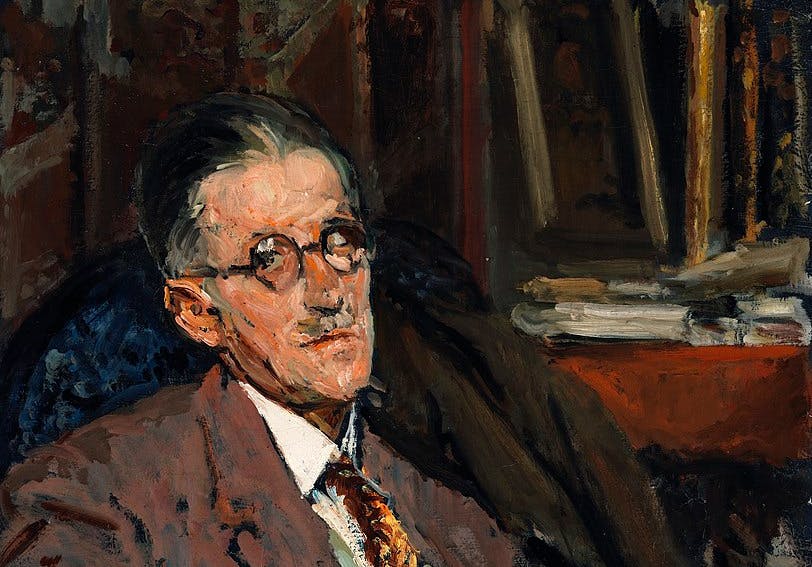A James Joyce Biography for Everyone
Gabrielle Carey’s brief biography collects the essential details of Joyce’s life and delivers them in a delightful, underplayed way.

‘James Joyce: A Life’
By Gabrielle Carey
Arden, 140 pages
The publisher’s promotional language is so striking, and so in keeping with the author’s sensibility, that it must be quoted in full: “If you know nothing about James Joyce but would like to, this is the book for you. If you know a little about James Joyce and would like to know more but not too much, this is the book for you. And if you are a die-hard Joycean who has spent your life puzzling over his work but know nothing about his life, this is also the book for you.”
The common complaint against modern literary biographies is that they tell too much, yet publishers insist on demanding biographies that are “definitive” while reviewers complain that lengthy books are exhausting. So imagine a reviewer’s or a reader’s delight in Gabrielle Carey’s brief biography, which collects the essential details of Joyce’s life and delivers them in a delightful, underplayed way.
Here is an example of a section that in a long Joyce biography might well be cited as superfluous and, in another age, even salacious: It concerns George Roberts, who considered publishing Joyce’s exquisite short story collection, “Dubliners”: “When Roberts wasn’t publishing, he was an actor in the Abbey Theatre and a traveling salesman of women’s undergarments. It is not known whether the two men bonded over this common interest” — in women’s drawers, that is, not the theater.
Carey’s sense of humor, and her willingness to leave some facts alone, is refreshing and also a sly comment about what biography cannot tell us and what at least some people would like to know. The Roberts passage might also lead a reader of Joyce to reflect on a memory of a passage in “Ulysses” in which Gertie MacDowell shows off her legs and a flash of her bloomers.
For readers who have shied away from the formidable “Finnegans Wake,” Carey provides just enough commentary about it and a few examples of the style to make it intriguing, even if she also quotes those critics who found the book a fraud.
Carey is very good at conveying Joyce’s humor — on and off the page. He had terrible problems with his eyes, exacerbated by his alcoholism. Instead of stopping his drinking, he wore an eyepatch to “rest his weaker eye,” Carey reports, and then adds: “Later, he described himself as ‘an international eyesore.’”
Joyce could joke about almost everything, which was his saving grace. When his daughter became mentally ill, though, the joking stopped and he despaired of saving her. Yet he wrote, no matter what, realizing that working on “Finnegans Wake” all day long would eventually sap him of life, which it did not so long after he completed his magnum opus.
Carey’s book has no chapter titles, and I like that. I stopped using chapter titles myself sometime ago, since they seemed factitious and never comprehensive enough to really capture what a chapter was about.
The short, numbered sections of Carey’s book mean she can be read consecutively, or during television commercials. Because there are no chapter titles, every section is a kind of adventure. You won’t get lost, as the book is basically chronological, and it’s also suspenseful, since you are kept wondering how Joyce will possibly survive to the next day to complete his work.
It came as a shock when I looked up Gabrielle Carey and discovered that she had died suddenly in May 2023. She was 64, perhaps still best known for her groundbreaking novel, “Puberty Blues,” written with Kathy Lette, which became a film and television series. “We made some mischief, Lette recalled, and broke some barriers by writing … our raw, earthy take on the brutal treatment of young women in the Australian surfing scene which is sadly, still so relevant.”
In the Sydney Morning Herald, Debra Adelaide observed that the first novel was just the beginning for a risk-taking writer not so different in sensibility from Joyce. Carey wrote memoirs about a fractured life that seemed nonetheless to function — just like the Joyce of her book.
Her 2020 biography, “Only Happiness Here: In Search of Elizabeth von Arnim,” resurrected an important but forgotten author who, like Joyce, was heroic in her devotion to writing as the only way she knew how to survive.
Mr. Rollyson is the author of “Lives of the Novelists.”

